| |
|
|
| |
"Summer" rolls on.
Thu 8th September, 2011
|
|
|
|
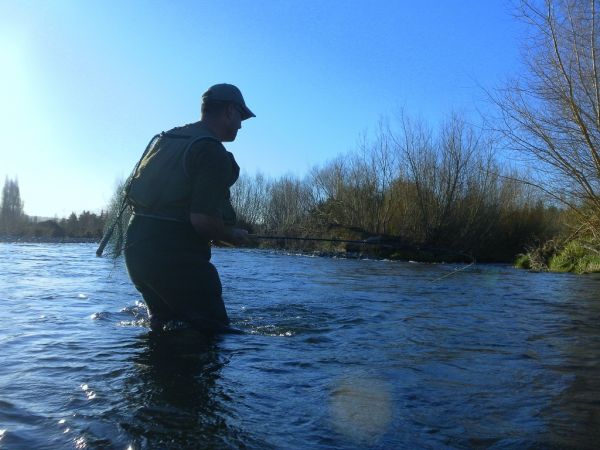
The summer-like conditions roll on and its been a fabulous week to be out and about on the Tongariro. With the river still clear and hovering around 24 cumecs most anglers are hoping for some of the wet stuff but be careful what you wish for. You only have too look at the archived reports to see that we usually get some pretty heavy rain during the next couple of months. Unfortunately it tends to come in big dumps and the river floods. This scrubs the river bed clean and the strong flows wash many of the weaker recovering fish straight back to Lake Taupo.
This affects our late spring and summer sport, especially if you enjoy using dry or dry and dropper methods. These "slabs" know that they need to eat to begin the process to repair their tired bodies. As they make the return journey they provide great sport and will have a go at virtually anything that looks like food. Hopefully once they reach the safety of the lake they'll quickly regain condition after feeding up on smelt. We need rain but just enough to put some color in the river, mix things up a bit and carry down more of the scents which help trigger the spawning runs.
It will probably never happen but even if it didn't rain you would have to assume that eventually the fish would still have to "go for it" no matter what.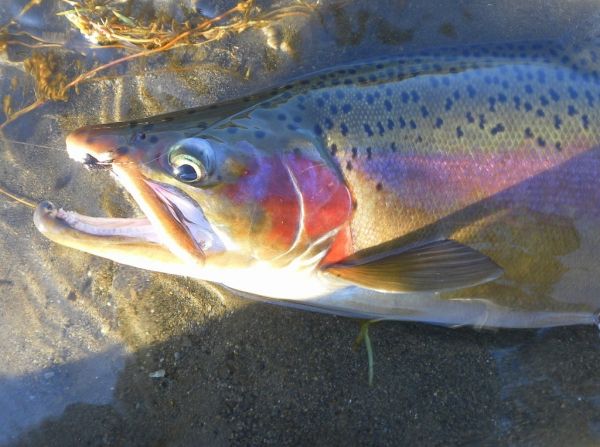
There have been fish moving all week but things seem to have slowed a little compared to last week. I spent a very pleasant but {fish wise} disappointing morning on the Upper river around Big Bend, Boulder and the Blue pool taking only two jacks. Around one o'clock I drove back to where the fish are and caught four before I got my feet wet much to the surprise of the angler waiting to cross. Justin had been struggling a bit all morning so I lent him my nymphing rod and we moved to another spot. A few casts later he landed this hen which took a small white caddis tied with a hint of UV flash.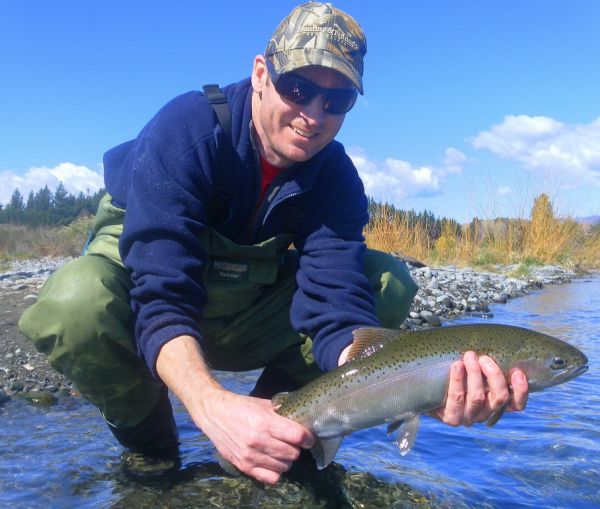
The next day I fished with Mike {the Rock} Hudson who has moved to North Island from Nelson. If you frequent the Turangi Bridge Motel you may recognise him because he works behind the bar. Mike was keen to try fly-fishing so with the promise of free beer until my three hundred dollar guiding bill is paid off we had a few hours on the river together. That's him pictured below holding his first ever trout caught on a fly. Just after this pic was taken he deliberately put a hole in the brand new waders I'd lent him, so that's been added to the bill as well. 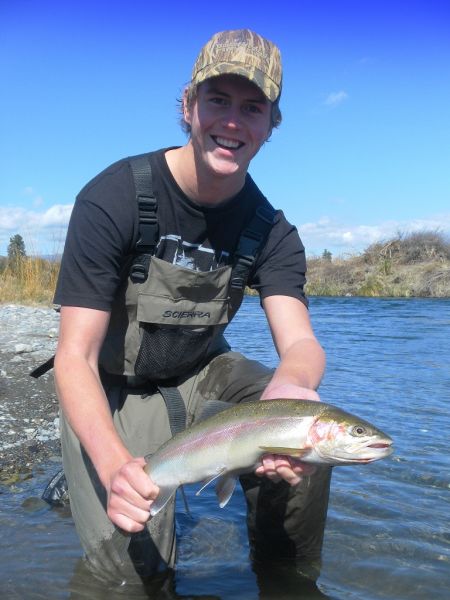
I've seen anglers catching some good fish as they ambush them in the Braids but a lot of them are not the classic chrome color that you would associate with fish that are fresh from the lake. I don't know for certain but it would suggest to me that they have been holed up somewhere lower down river before making the spawning dash upstream. The enthusiastic way some of them are taking caddis and mayfly imitations they are fully aware that its not only fish eggs that are on the Tongariro menu.
Its "sods law" that the only pic I have of me holding a fish this week has a great big globug stuck in its mouth but in the clear conditions I've caught more on naturals.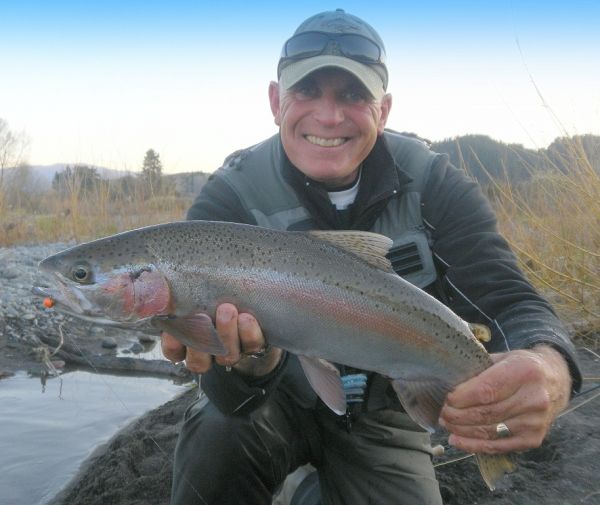
Everyone has an opinion on whether or not Taupo fish continue to feed on their spawning migration. My take for what its worth is that they do...I just find it difficult to believe that the thousands of trout caught on rivers like the Tongariro take a fly purely out of aggression or curiosity. Mathew McHugh is a writer, fisho and angling travel consultant specializing in among other places New Zealand. He also has a degree in aquatic science he says of N.Z lake trout "Browns and rainbows continue to feed on their spawning migrations unlike some other salmonid species and therefore can be caught using a variety of techniques depending on the species being targeted and the conditions of the day" and then later he continues "The closer the fish get to their spawning beds however the less likely they are to take a fly and the more interested they become in each other as their sexual urges take over"
This makes sense to me, as I mentioned above some of the fish moving through recently have lost that silver bullet look but are still fit and in great nick. This would suggest they have been scoffing something while in the river but I'm sure someone else will have a very different theory.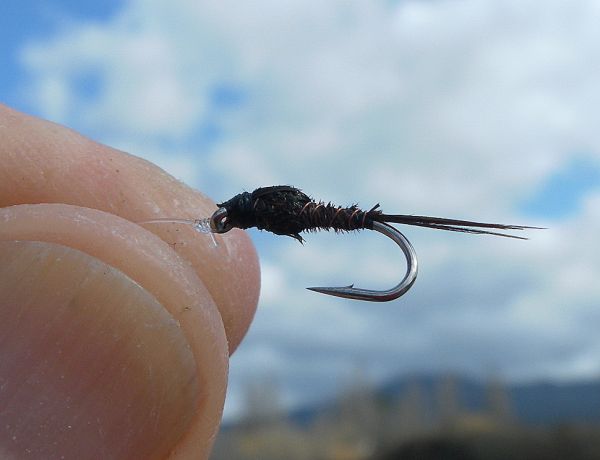
Last week we had a look at the Pheasant Tail nymph and its creator Frank Sawyer M.B.E. This extraordinary angler was once credited with saying that he was confident he could catch trout anywhere in the world using only his famous five patterns and I firmly believe he would have. The last couple of days the P.T. nymph has proved its worth including this lively jack. I've been using one tied without any added bling, not quite the same as the original but near enough. Sawyer had an uncanny knack of turning quite ordinary materials into flies which have stood the test of time. The copper wire used in a number of his nymphs is reputed to have come from a stripped dynamo. His much copied "bow-tie buzzer" is constructed of wire, tin foil, a few feather fibers and a tiny piece of white wool. But the fly that has caused most debate or to be precise the stuff its made of is the "Killer Bug". Sawyer originally tied the fly to mimic the fresh water shrimps that the grayling in the Avon fed upon. It proved so deadly that he used it to cull their numbers. Grayling were an unwelcome species in a trout fishery back then but are now a highly regarded sporting fish. It soon became obvious that it wasn't only grayling that found the "bug" irresistible and the story began. I've been using one tied without any added bling, not quite the same as the original but near enough. Sawyer had an uncanny knack of turning quite ordinary materials into flies which have stood the test of time. The copper wire used in a number of his nymphs is reputed to have come from a stripped dynamo. His much copied "bow-tie buzzer" is constructed of wire, tin foil, a few feather fibers and a tiny piece of white wool. But the fly that has caused most debate or to be precise the stuff its made of is the "Killer Bug". Sawyer originally tied the fly to mimic the fresh water shrimps that the grayling in the Avon fed upon. It proved so deadly that he used it to cull their numbers. Grayling were an unwelcome species in a trout fishery back then but are now a highly regarded sporting fish. It soon became obvious that it wasn't only grayling that found the "bug" irresistible and the story began.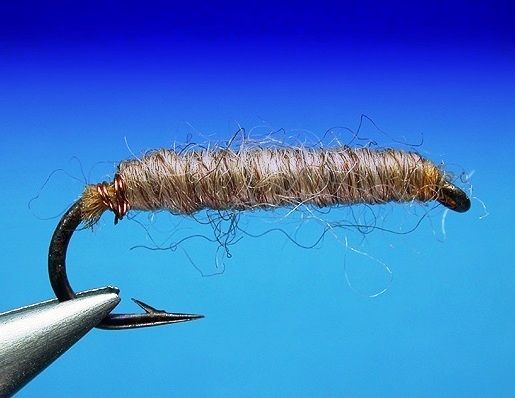
This is another of Frank Sawyers deceptively simple patterns that in the right hands is an absolute killer...hence the name. Again only two materials are used copper wire and the wool that over time has been described by many as having "mystical" fish catching properties...Chadwicks mending yarn with the dye batch number 477. Before it became as rare as a queer tom-cat a card of this wool cost a few old British pennies. Nowadays fly-tiers intent on replicating the original pattern will pay hundreds of dollars for it. The Chadwick Mill stopped producing it in the 1960's after a fire destroyed records of the exact dying recipe. They did continue with the nearest color to it which was number 454 but they stopped making that over twenty five years ago.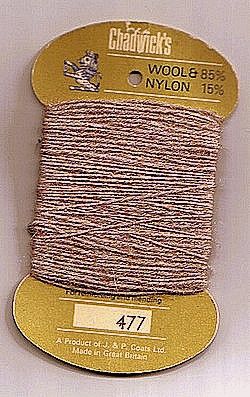 All of this has added to the intrigue surrounding this very ordinary looking fly. All of this has added to the intrigue surrounding this very ordinary looking fly.
Although intended to mimic a fresh water shrimp anglers have described it as looking like a maggot or grub and Sawyer thought that trout may have been mistaking it for a caddis.
As supplies dwindled eventually even the inventor himself had to source a different supply which was explained in this reply to a query about Chadwicks 477 sent to his grandson Nick;
"Frank did indeed have a substitute made by an American he met on the river bank. This same gentlemen still provides me with the substitute wool. It is the colour of the wool when wet which is important and this is affected by the colour and thickness of the copper wire beneath the wool. The colour of the wool is reasonably important but by far the most important element of the Killer Bug is the manner in which it is fished.
I have tried many substitutes of suitable colour but the main problem has been the fibres rather than the colour - it is important to have the right thickness and the correct mix of natural to artificial fibres. I have no idea what the correct ratio should be, but high levels of artificial fibres make for a poor Killer Bug.
Here is a handy guide for Killer Bug fishermen:
1. Get the technique right - it is possible to catch fish on a bare
hook if fished in a natural manner.
2. Get the weight of the Killer Bug right - it should sink quickly but
not so quickly that the current doesn't affect it.
3. The wool covering should be 2-3 layers only so that the copper wire beneath the wool gives the Killer Bug a translucent appearance when wet.
4. It doesn't matter what colour the dry wool is, but when wet and wound over copper wire it should be grey/brown with a slight pink tinge".
5. Did I mention to get the technique right!
Killer Bugs made with the substitute wool and a booklet on the correct Killer Bug technique are available from my website www.sawyernymphs.com
Tight Lines,
Nick Sawyer"
Personally I think the effectiveness of the "Killer Bug" probably had more to do with the skill of the legendary angler fishing with them than the yarn itself. I've haven't tried one on the Tongariro but love the idea of a never fail fly. Next time I'm passing a haberdashery shop I think it may be worth a sneaky look to see if they have a browny grey wool with a pink tinge... although I'm not too sure they'll like me spitting all over their yarn samples to see if they turn the right color when wet.
If your interested in tying a few up, there is a very good demonstration video on You Tube by Scottish fly tier Davie McPhail or you could order some from www.sawyernymphs.com
There have been a lot of jacks caught this week, not slabs but fit stroppy males in full spawning uniform just like the one Aaron Loder is holding...he's playing it in the lead photograph. Who knows may be their waiting for a fresh run of ladies to arrive...we'll find out in the next few days.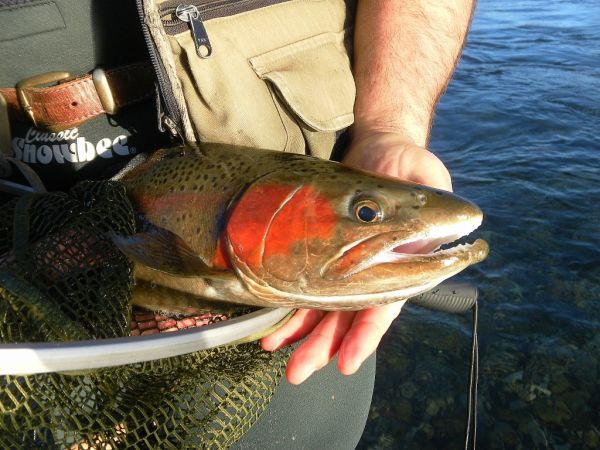
Have Fun Guys
Mike |
|
|
| Back to Top |
|
|
|
|
| |
| COMMENTS |
|
Hi Mike- we met last week.
Great to see the report- although I fear Jason will dine out on his feature photo for many years to come!
I just wanted to say hello on here- thank you again for the great website and reports...and thanks also for all the tips you provided. I had an excellent couple of days & can't wait to return.
Keep up the good work.
cheers
Andrew |
|
|
|
| AndyB | Tue 13th September, 2011 | |
|
|
|
| |
|
|
|